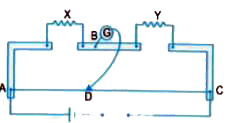(a) In a metre bridge shows in given figure the balance point is found to be at 39.5 cm from the end A, when the resistor Y is of 12.5Ω. Determine the resistance of X. Why are the connections between resistors in a Wheatstone or metre bridge made of thick copper strips?
(b) Determine the balance point of the metre bridge if X and Y are interchanged.
(c ) Waht happens if the galvanometer and cell are interchanged at the balance point of the bridge? Would the galvanometer show any current?

(a) For a balanced metre bridge, we have XY=l1l2
⇒X=l1l2Y
Here, I1=39.5cm
l2=100−39.5=60.5cm
Y=12.5Ω
∴X=39.5×12.560.5=8.2Ω
To minimise the resistance of those connections which are not mentioned for in the formula for the bridge, we use thick copper strips because the resistance of a conductor decreases on increasing the area of cross section and choosing a material of low resistivity like copper.
(b) On interchaning X and Y, we have
l1l2=YX
⇒l1l2=12.58.16
⇒l1l2=1.531
∴l1=100×1.532.53=60.5cm
Thus the new balance point will be 60.5 cm from A.
(c ) On exchanging galvanometer and battery, the Wheatstone bridge will still remain balanced. So, the galvanometer will not show any current
Topper's Solved these Questions
- CURRENT ELECTRICITYBOOK - MODERN PUBLICATIONCHAPTER - CURRENT ELECTRICITYEXERCISE - NCERT SOLVED (NCERT Additional Exercises)
11 Videos
- CURRENT ELECTRICITYBOOK - MODERN PUBLICATIONCHAPTER - CURRENT ELECTRICITYEXERCISE - NCERT SOLVED (NCERT Exemplar Problems Subjective Questions)(Very Short Answers Type Questions)
10 Videos
- CURRENT ELECTRICITYBOOK - MODERN PUBLICATIONCHAPTER - CURRENT ELECTRICITYEXERCISE - TOUGH AND TRICKY PROBLEMS
23 Videos
- ATOMS BOOK - MODERN PUBLICATIONCHAPTER - ATOMS EXERCISE - Chapter Practice Test
16 Videos
- DUAL NATURE OF RADIATION AND MATTER BOOK - MODERN PUBLICATIONCHAPTER - DUAL NATURE OF RADIATION AND MATTER EXERCISE - CHAPTER PRACTICE TEST
15 Videos
Similar Questions
(a) In a metre bridge the balance point is found to be at 39.5 cm from the end A, when the resistor Y is of 12.5 Ω . Determine the resistance of X. Why are the connections between resistors in a Wheatstone or metre bridge made of thick copper strips ?
(b) Determine the balance point of the bridge above if X and Y are interchanged.
(c ) What happens if the galvanometer and cell are interchanged at the balance point of the bridge? Would the galvanometer show any current ?

View SolutionWhy are the connections between resistors in a metre bridge made of thick copper strips ?
View Solution
Knowledge Check
The points in a metre bridge is at 35.6 cm. if the resistances in the gaps are interchanged, the new balance point is
A64.4 cmB56 cmC41.2 cmD56.7 cmIn a metre-bridge experiment, when the resistances in the gaps in the gaps are interchanged, the balance-point did not shift at all. The ratio of resistances must be
Avery largeBvery smallCequal to unityDzeroIn a metre bridge expt, when the resistances in the gaps are interchanged the balance point is increases by 10 cm. The ratio of the resistances is
A155B128C119D109
(i) In a metre bridge, the balance point is found to be at 39.5 cm from the end A, when the resistor Y is of 12.5Ω. Determine the resistance of X. Made of thick copper strips?
(ii). Determine the balance point of the bridge above if X and Y are interchanged.
(iii). what happens if the galvanometer and cell are interchanged at the balance point of the bridge ? Would the galvanometer show any current?
View Solution(i) In a metre bridge, the balance point is found to be at 39.5 cm from the end A, when the resistor Y is of 12.5Ω. Determine the resistance of X. Made of thick copper strips?
(ii). Determine the balance point of the bridge above if X and Y are interchanged.
(iii). what happens if the galvanometer and cell are interchanged at the balance point of the bridge ? Would the galvanometer show any current?
View SolutionWhy are the connecting resistors in a meter bridge made of thick copper strips ?
View SolutionAnswer the following :
(a) Why are the connections between the resistors in a meter bridge made of thick copper strips?
(b) Why is it generally preferred to obtain the balance point in the middle of the meter bridge wire?
View SolutionAnswer the following :
(a) Why are the connections between the resistors in a meter bridge made of thick copper strips?
(b) Why is it generally preferred to obtain the balance point in the middle of the meter bridge wire?
( c) Which material is used for the meter bridge wire and why?
View Solution
